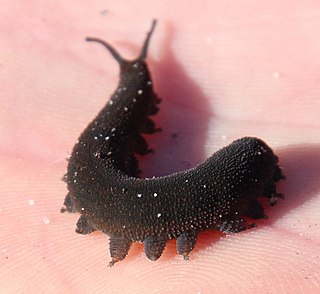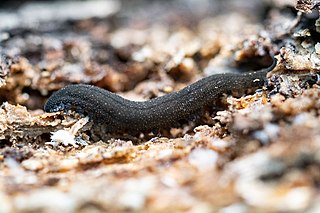Metaperipatus is a genus of velvet worms in the family Peripatopsidae that contains two species found in Chile, including Metaperipatus inae. This genus was created by the American zoologist Austin Hobart Clark in 1913 to contain the type species, M. blainvillei. Authorities believe M. blainvillei is a species complex, however, and some consider M. blainvillei a nomen dubium.
Paraperipatus is a genus of velvet worms in the family Peripatopsidae. This genus exhibits matrotrophic viviparity, that is, mothers in this genus retain eggs in their uteri and supply nourishment to their embryos, but without any placenta. Species in this genus are found in New Guinea and the surrounding islands, including the Maluku achipelago.
Eoperipatus horsti is a species of velvet worm in the Peripatidae family. Authorities have designated this velvet worm as the type species for the genus Eoperipatus, because among the species originally included in this genus, this species is the only one known from descriptions of both sexes. This species is found in Malaysia.
Epiperipatus hilkae is a species of velvet worm in the Peripatidae family. This species is found in Costa Rica. This velvet worm is closely related to another species of Epiperipatus found in Costa Rica, E. isthmicola. The species E. hilkae is named in honor of the German zoologist Hilke Ruhberg for her extensive work on velvet worms.
Euperipatoides leuckartii is a species of velvet worm in the family Peripatopsidae. This species is ovoviviparous and has 15 pairs of oncopods (legs). Females of this species range from 5 mm to 40 mm in length, whereas males range from 4 mm to 29 mm. The type locality of this species is Mount Tomah, New South Wales, Australia.
Oroperipatus lankesteri is a species of velvet worm in the Peripatidae family. This velvet worm is notable for its large size, reaching 82 mm in length. This species is known only from its type locality in the northern Pacific lowlands of Ecuador.
Oroperipatus peruvianus is a species of velvet worm in the Peripatidae family. Males of this species have 34 pairs of legs; females have 36 or 37 pairs. This velvet worm is found in Peru.
Oroperipatus weyrauchi is a species of velvet worm in the Peripatidae family. The original description of this species is based on only two specimens, a male with 40 pairs of legs and a larger female with 38 leg pairs. The type locality is in Peru.
Peripatus dominicae is a species of velvet worm in the Peripatidae family. The type locality for this species is on the Caribbean island of Dominica. Although the Canadian zoologist Stewart Peck introduced the name Peripatus dominicae dominicae in 1975 to distinguish the original species from other subspecies then assigned to P. dominicae, authorities now deem these subspecies to be separate species in light of the significant distances between their type localities.
Paraperipatus ceramensis is a species of velvet worm in the family Peripatopsidae. This species is grey-green with rust speckles. Females of this species have 21 or 22 pairs of legs and range from 13 mm to 55 mm in length. The type locality is in Seram, Indonesia.
Paraperipatus novaebritanniae is a species of velvet worm in the Peripatopsidae family. This species is black with brown-yellow spots. Females of this species have 24 pairs of legs; males have 22 or 23 leg pairs. Females range from 14 mm to 55 mm in length, whereas males range from 14 mm to 26 mm. The type locality is in New Britain, Papua New Guinea.
Paraperipatus papuensis is a species of velvet worm in the Peripatopsidae family. This species is a pale greenish blue. Females of this species may have as few as 21 pairs of legs or as many as 29 pairs, exhibiting the greatest intraspecific variation in leg number found in any peripatopsid species. Males of this species range from 21 to 27 leg pairs. The maximum number of leg pairs recorded in this species (29) is also the maximum number of leg pairs found in the family Peripatopsidae. Females range from 22 mm to 83 mm in length, whereas males range from 19 mm to 45 mm. The type locality is in Western New Guinea, Indonesia.
Paraperipatus lorentzi is a species of velvet worm in the Peripatopsidae family. This species is a dark green-blue. Females of this species have 22 to 28 pairs of legs; males have 21 or 22 pairs of legs. Whereas the original description of this species records 19 mm as the length of a male specimen, females range from 33 mm to 60 mm in length. The type locality is in Western New Guinea, Indonesia. The validity of this species is uncertain: Although some authorities deem P. lorentzi to be a junior synonym of P. papuensis, a similar species also found in Western New Guinea, others recognize them as two separate species.
Paraperipatus vanheurni is a species of velvet worm in the Peripatopsidae family. This species ranges from pale blue or lilac to dark purple in color. Females of this species have 25 to 27 pairs of legs; males have 21. This species ranges from 15 mm to 60 mm in length. The type locality is in Western New Guinea, Indonesia.
Peripatopsis balfouri is a species of velvet worm in the Peripatopsidae family. This species has 18 pairs of clawed legs. Also known as the blue velvet worm, this species ranges from 9 mm to 22 mm in length. The type locality is in South Africa.

Peripatopsis capensis is a species of velvet worm in the Peripatopsidae family. This species has 18 pairs of legs: 17 pregenital leg pairs with claws plus one strongly reduced last pair without claws or spinous pads. Females of this species range from 9 mm to 70 mm in length, whereas males range from 6 mm to 54 mm. The native range of this species is limited to the Cape Peninsula of South Africa.

Peripatopsis moseleyi is a species of velvet worm in the Peripatopsidae family. Males of this species have 20 to 24 pairs of legs with claws ; females have 19 to 23 pairs of legs with claws. Females range from 11 mm to 75 mm in length, whereas males range from 9 mm to 50 mm. The type locality is in South Africa.
Peripatopsis sedgwicki is a species of velvet worm in the Peripatopsidae family. Also known as the Tsitsikamma velvet worm, this species has a narrow geographic distribution in South Africa but is especially abundant in the indigenous forest of the Tsitsikamma mountains. Recent phylogenetic analysis suggests that Peripatopsis sedgwicki is a species complex that contains three clades, each with a distinct geographic distribution, including at least one clade that may represent a novel species.

Peripatopsis overbergiensis, the Overberg velvet worm, is a species of velvet worm in the Peripatopsidae family. This species usually has 19 pairs of legs: 18 pregenital leg pairs plus one last pair that is strongly reduced and without claws or spinous pads. Some individuals, however, have only 18 leg pairs. This species is limited to the Overberg region of South Africa.
Ooperipatellus nickmayeri is a species of oviparous velvet worm in the family Peripatopsidae. This species is larger than any other in the genus Ooperipatellus. With a body size exceeding 60 mm in females and 30 mm in males, these velvet worms can be more than twice as long as other species of this genus.


